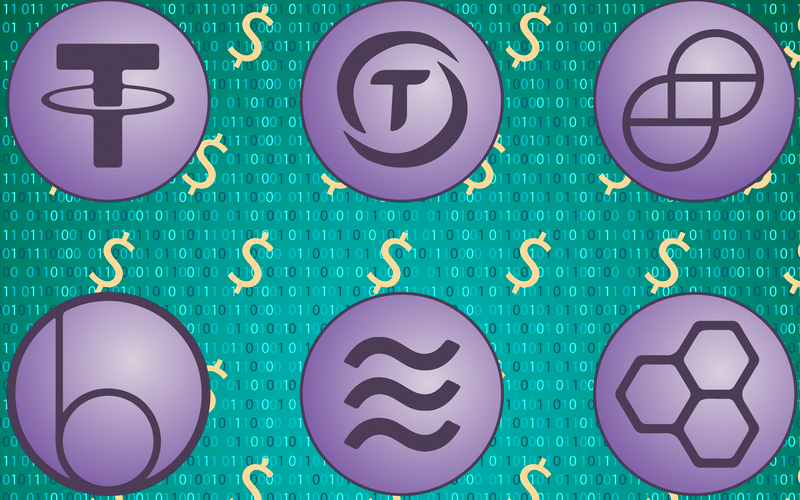Stablecoins are cryptocurrencies whose values are tethered to another asset. The most common forms of stablecoins are fiat-backed, cryptocurrency-backed, and commodities-backed stablecoins. Because they are tethered to other assets, stablecoins aim to achieve stability that isn’t typical of cryptocurrencies.
Traditional currencies are held in high value and are trusted becatheire of the backing from governments. Stablecoins aim to go the extra mile by giving both stability and the privacy and ease that come with crypto transactions.
Most stablecoins use the US dollar as their collateral, but the euro and JPY are also being integrated. As a result of getting their backing from a central authority, their value fluctuates very little. This is in contrast to the volatile value of other well-known cryptocurrencies like bitcoin and ethereum.
While all cryptocurrencies are volatile, stablecoins are less so. Even so, they retain a large part of the appeal of other cryptocurrencies, giving investors an entry point into a new and rapidly developing asset category.
Types of stablecoins
Coins backed by fiat currency
One of the most well-known fiat-backed stablecoins is Tether (USDT). This coin’s solvency is dependent on its reserves’ strength and only includes 3.87 percent in cash, which are pegged at one a ratio of 1:1 to the USD.
USDC is another dollar-pegged stablecoin, and it was introduced by Coinbase and Circle three years ago. It is important to note that there are also centralized stablecoins, which refers to stablecoins that a single institution controls. For instance, USDC is controlled by Circle and Coinbase.
When it comes to centrally controlled stablecoins, one danger is putting your faith in the central authority to keep dollar supplies constant. Critics argue that this goes against the principle of decentralization.
In addition to Tether and USDC, other well-known fiat-tethered stablecoins include PAX Circle and TrustToken, stablecoins backed by commodities.
As you may infer from their name, these are stablecoins whose value is tethered to underlying commodities. Usually, such commodities are highly valuable assets like precious metals or fast-moving commodities like oil.
Holding a commodity-backed stablecoin is like owning a genuine asset with real value, which is not the case with most cryptocurrencies. Investors are more likely to keep and utilize these currencies if they offer the potential for appreciation in value over time.
When markets are volatile, and inflation is on the rise, gold is an attractive addition to investment portfolios. A gold-backed stablecoin, Digix, allows investors to invest in gold without worrying about transporting and keeping it themselves.
Stablecoins supported by cryptocurrencies
These stablecoins are backed by a corresponding amount of other crypto assets. Stablecoins backed by cryptocurrencies are overcollateralized to protect their value against fluctuations in the underlying asset. Another cryptocurrency is used to secure stablecoins in this case.
It’s important to note that, due to the volatility of crypto prices, these Stablecoins must use a series of protocols to ensure that their dollar value remains constant over time.
So, let’s assume we deposit $200 in DOGE and get back $ 100 worth of a stablecoin. This means that a total of 200 percent of the stablecoins’ value has been backed up with fiat currency. Therefore, even if DOGE declines by 50%, there will still be $ 100 worth of collateral supporting the value of the stablecoin. This ensures that the value of stablecoins is protected. MakerDAO and Havven are two of the most popular stablecoins.
Non-collateralized stablecoins
The quantity of stablecoins in circulation is controlled by an algorithm. It’s a type of stock called seigniorage shares.
Most stablecoins are minted to keep up with rising demand and bring the price back down to normal. The algorithm will restrict the supply of the coin if it is trading at a low price. Theoretically, the price of these stablecoins will remain stable due to maintaining a delicate balance between supply and demand.
For non-collateralized coins to maintain their viability, they need to grow indefinitely for as long as their demand grows. A crash would result in the loss of all money because there would be no collateral to sell the coin into, and it would be impossible to recover it. Nonetheless, stablecoins that aren’t collateralized to anything else are the most decentralized and independent.
Where to buy stablecoins
In order to buy stablecoins, you’ll need a cryptocurrency exchange account or a digital wallet to keep your purchased cryptocurrencies. You should double-check whether the services you desire are available in your area because some services may not be offered in all areas.
Stablecoins may be listed on centralized exchanges. However, these exchanges may only list fiat-backed versions of the coins. If you want more possibilities, you can use a decentralized exchange to convert any current tokens into the most stablecoins.
In summary
Even though many believe Stablecoins is a secure haven, the harm they do to cryptocurrencies must also be considered. They can potentially render a severe blow to cryptocurrency prices while also protecting their own values.
